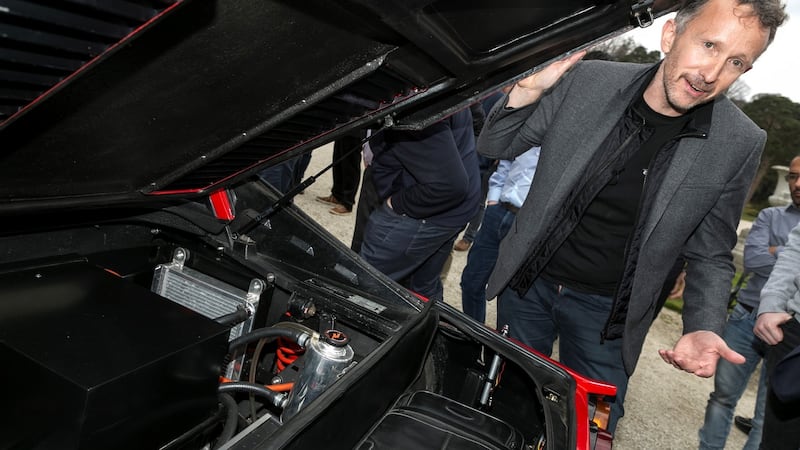"If you look at what the new automotive world is, it's much more analogous to software than it is to traditional vehicle manufacturing," Norman Crowley says. "And if Ireland doesn't jump on this opportunity, then we're going to miss one of the biggest waves that's going to happen over the next decade. We're very much of the opinion that we, and Ireland, should be a key part of it."
As ripostes from a chief executive to a journalist asking, in not so many words, if he’s taken leave of his business senses, it’s a pretty gentle one.
Others might have slammed the phone down, but Crowley is not your average AN Other executive. He has a vision of Ireland playing a major part in the global clean energy revolution that is really only just getting started and he's currently establishing a centre for vehicle design and manufacturing in Powerscourt, Co Wicklow.
Think of building cars in Ireland and one’s mind immediately goes back to Ford’s vast factory in Cork, which failed to survive the twin blows of recession and changes to Ireland’s car taxation laws. Or of John DeLorean’s hubristic dreams of building a futuristic sports car in Belfast (while simultaneously squeezing every possible penny out of the British exchequer).
Crowley’s new AVA Automotive will be similar to neither of those.
"There are fundamental differences," says Crowley. "Not least in that we are starting with small-volume production. If you look back at DeLorean, what they were trying to do was to design a brand new type of car, one that proved much more difficult to design than it had been thought, and then to go straight into volume production.
“If you look back to that time, too, back when Ford was still in Cork, Ireland back then was a horrible place in which to do business. It’s a very different world now.”
So different a world that Crowley’s plans to produce an ultra-high performance electric supercar in Wicklow, drawing inspiration from the classic 1960s Corvette Stingray sports car – and for which he will charge a price tag of something between €1 million and €2 million – has drawn deposits and excitement, instead of disbelief and derision.
This high-speed model, which will be made by AVA in Powerscourt, still has no name beyond the placeholder title of Hyperclassic. Crowley says an initial sketch of how it will look will be shown shortly.
The allusion to classic Corvettes is more than mere empty words, though. Crowley has engaged the services of none other than Peter Brock, who worked on the original Stingray with General Motors design legend Harley Earl, to help create the new car, and he has also linked up with former head of Jaguar design Ian Callum to help put it into production.

While it will be retro in looks, the AVA Hyperclassic will be anything but in performance, if Crowley’s claims hold up. It will have at least 1,200hp from two electric motors, and will use a cutting-edge “skateboard” chassis, incorporating both motors and battery. That will not be a bought-in unit, but one that AVA will design and engineer itself.
“Our first year of production for the car will be 2022, and we want to build 10 initially,” says Crowley. “The idea is that by selling something low-volume and high-price at first, we can then use that money to finance further developments.” Those developments will, says Crowley, include new models that are much more affordable.
Conversions
Part of the business model is also the conversion of older, classic models to electric power. Crowley has already shown skills in that area through his existing Electrifi Ireland business, which previously converted a 1980s Ferrari 308 GTS (yes, the Magnum PI-style one) to battery power.
Next up is a collaboration with UK-based Land Rover restoration specialists ACH Classic to put batteries and motors into classic Land Rover Defenders.
“There’s a huge appetite to convert existing vehicles,” says Crowley. “But you have to start at the higher end of the market. If you go to convert, say, a three-year-old Focus, then the economics don’t add up.
“If you start with classics, with cars that are worth more than, say, €100,000, then you can afford to convert it. Our conversions are sold out to 2023, so there’s clearly monster demand for it. We’ll slowly move into what you might call ‘regular’ vehicles, but it’ll take a while.”
Funding for the AVA project comes from Crowley's previous businesses, including Trinity Commerce, Inspired Gaming Group and The Cloud, all of which he sold for a reputed €750 million.
Last year, Crowley's Cool Planet company (which includes Crowley Carbon and Electrifi) raised €31 million in funding, partly from French group Tikehau Capital with London-based Systemiq Incubation.
As for worries that those who previously invested heavily in making cars in Ireland ended up with burned fingers?
“When you look at everything we’ve tried to do over the years, other people have failed in the same businesses, such as setting up a global energy business. We’ve got a very strong team, with a very strong track record. These are major global trends that we’re focusing on, and it all plays to our strengths.”




















